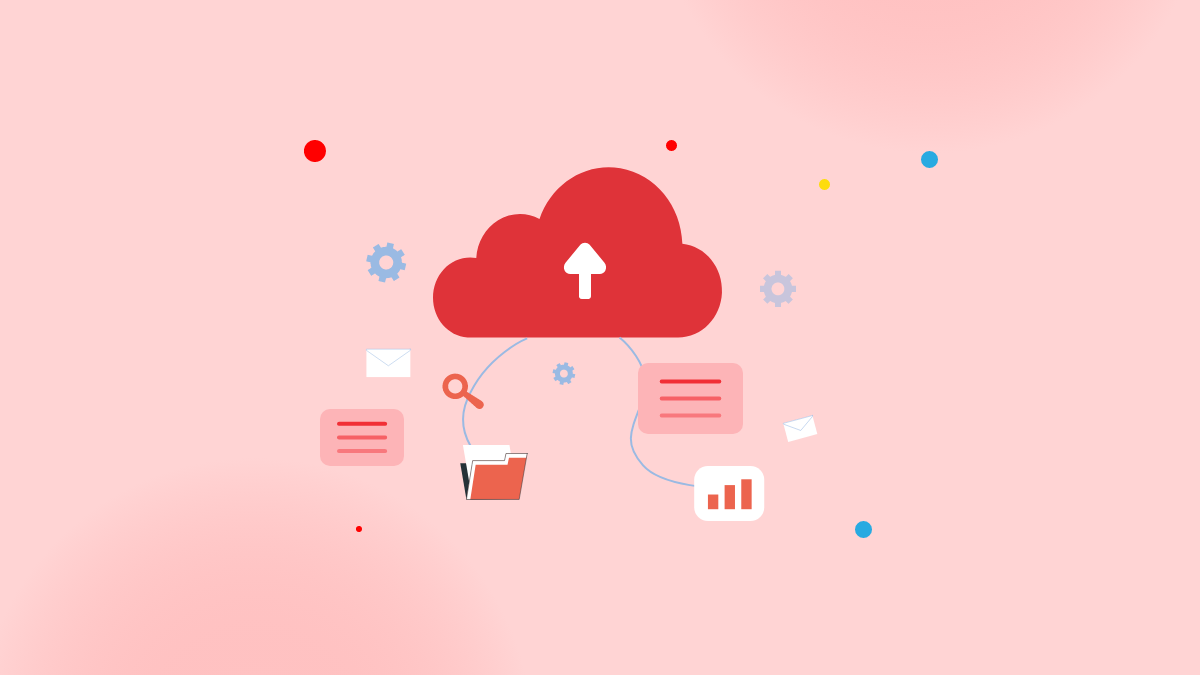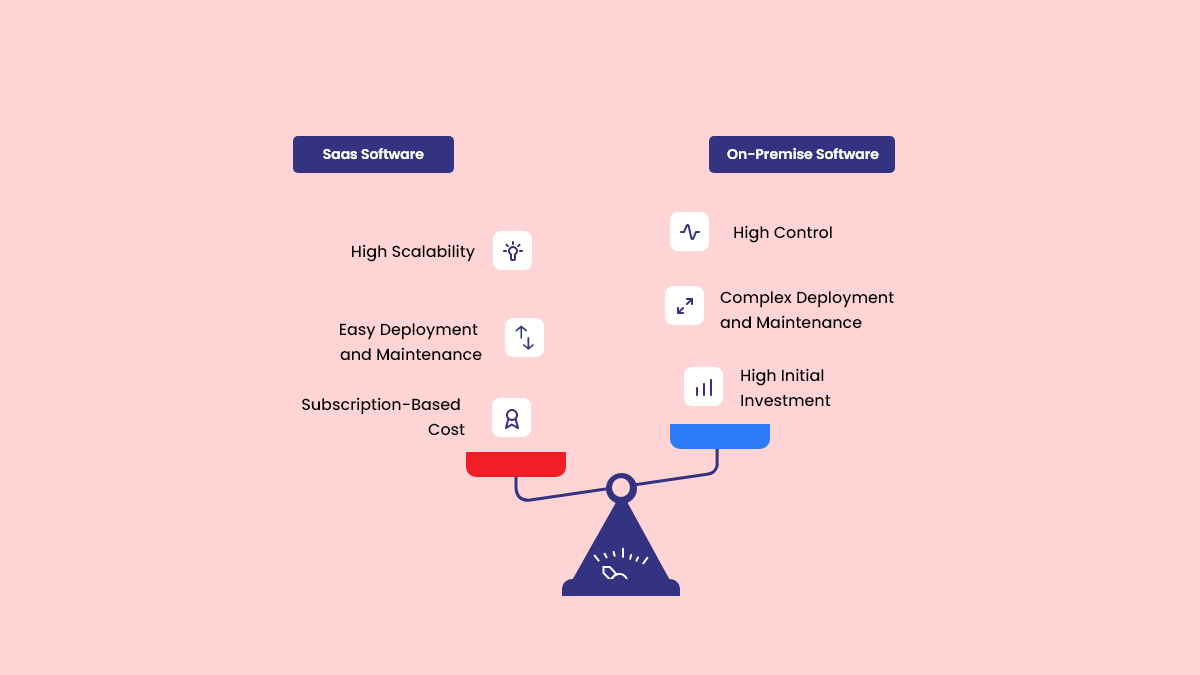
Introduction
Digital transformation is no longer a buzz-phrase. By 2024, nearly half of all enterprises reported that they were actively adopting cloud and edge computing technologies, making deployment strategy a board-level conversation (McKinsey Technology Trends Outlook 2024). At the same time, the global SaaS market has ballooned to roughly $3 trillion, with forecasts of up to $10 trillion by 2030.
Why the acceleration? Because the stakes are high. Accenture’s 2024 Pulse of Change Index shows a 183 percent jump in the rate of change hitting businesses since 2019, driven largely by technology disruption. Meanwhile, PwC’s 2024 Cloud & AI Business Survey links cloud-powered organisations with superior growth and productivity outcomes.
Against this backdrop, selecting SaaS or On-Premise software touches every metric that matters: productivity, total cost of ownership, scalability, and regulatory compliance. So, which model is the best fit for your business in 2025?
SaaS vs On-Premise: At a Glance
| Feature | SaaS (Software as a Service) | On-Premise Software |
| Deployment | Cloud-based, accessed via the internet | Installed locally on company servers |
| Cost Structure | Subscription model with low upfront spend | High initial CAPEX, lower ongoing OPEX |
| Scalability | Elastic capacity on demand | Scaling requires additional hardware and investment |
| Updates & Maintenance | Automatic, handled by provider | Managed internally with manual patching |
| Security & Compliance | Shared-responsibility model, may face data-sovereignty considerations | Full control of data residency and security posture |
| Customization | Limited to provider’s configuration options | Deep, code-level customization possible |
| Accessibility | Any device, anywhere with internet | Primarily on-site; remote access needs VPN or similar |
| Vendor Dependency | High – relies on provider uptime and roadmap | Low – organisation governs lifecycle and support |
Key Takeaways
- SaaS excels when speed, global access, and predictable operating expenses are priorities. Automatic updates and an API-first architecture make it ideal for rapid innovation and AI-driven automation.
- On-Premise remains compelling where strict data sovereignty, deep customization, or low-latency workloads are mission-critical. Long-term cost efficiency can emerge for large enterprises with stable demand profiles.
These contrasts underscore why deployment strategy has become a pivotal lever in digital-transformation roadmaps. Choosing wisely begins with clearly mapping your organisation’s risk tolerance, growth ambitions, and compliance landscape.
SaaS in 2025: The Agile Standard
 Cost-Efficiency and Predictable Budgeting
Cost-Efficiency and Predictable Budgeting
In 2025, Software as a Service (SaaS) continues to offer businesses a cost-effective alternative to traditional software models. By adopting a subscription-based approach, companies can avoid substantial upfront investments in hardware and software licenses. This model not only reduces initial expenditures but also provides predictable ongoing costs, facilitating better financial planning and budgeting. According to PwC, integrating AI into business strategies can lead to significant productivity gains and revenue growth, emphasizing the value of scalable and cost-efficient solutions like SaaS.
Rapid Deployment and Scalable Growth
SaaS solutions are renowned for their rapid deployment capabilities. Unlike traditional on-premise systems that may take weeks or months to implement, SaaS applications can often be set up and operational within days. This swift deployment allows businesses to respond quickly to market changes and scale their operations as needed. McKinsey highlights that companies embracing AI and SaaS technologies can significantly reduce product development lifecycles, enabling faster time-to-market and enhanced competitiveness.
Maintenance-Free Operation
One of the key advantages of SaaS is the elimination of maintenance responsibilities from the client’s side. Service providers handle all updates, security patches, and system maintenance, ensuring that clients always have access to the latest features and security enhancements without additional effort or cost. This hands-off approach reduces the burden on internal IT teams and minimizes operational risks associated with outdated software.
Remote Access and Global Team Support
The cloud-based nature of SaaS enables users to access applications from anywhere with an internet connection, supporting the growing trend of remote and distributed workforces. This accessibility ensures that teams across different geographies can collaborate effectively and maintain productivity. McKinsey’s research indicates that employees are increasingly ready to adopt AI and digital tools, with many already utilizing such technologies to enhance their work.
Built for Automation and Integration
Modern SaaS platforms are designed with integration and automation in mind. They often feature API-first architectures, allowing seamless connectivity with other tools and systems. This design facilitates the automation of workflows and the incorporation of AI-driven functionalities, leading to improved efficiency and innovation.
By leveraging the advantages of SaaS, businesses can position themselves for greater agility, scalability, and innovation in 2025 and beyond.
On-Premise in 2025: Control, Security, and Customization
Full Data Sovereignty and Compliance
In 2025, data sovereignty continues to be a decisive factor for organizations in regulated sectors such as finance, government, and healthcare. On-premise software gives businesses complete control over sensitive data by keeping it within internal infrastructure—no third-party hosting, no jurisdictional ambiguity. This makes it easier to meet strict data compliance regulations like GDPR, HIPAA, and country-specific cybersecurity laws.
Deep Customization for Complex Systems
One of the strongest on-premise software benefits is the ability to deeply customize the solution to fit specific workflows, legacy systems, and business logic. Whether it’s tailoring data structures, modifying user interfaces, or integrating with proprietary hardware, on-premise deployments offer unmatched configurability. A 2024 IDC survey revealed that nearly half of enterprise IT leaders prioritize software customization as a reason to maintain on-premise deployments
High Performance for Demanding Use Cases
For industries where performance is non-negotiable—like manufacturing, finance, or defense—on-premise systems provide faster response times by processing data locally. This is especially true in edge computing environments, where minimizing latency can mean the difference between success and system failure. According to Forrester’s 2024 insights, enterprise edge computing is a key driver behind the continued relevance of on-premise setups for mission-critical workloads.
 Cost Advantages Over the Long Haul
Cost Advantages Over the Long Haul
While the initial cost of on-premise deployment is high, the total cost of ownership (TCO) may prove lower over time for enterprises with predictable software needs. By avoiding recurring subscription fees and capitalizing on existing internal IT capabilities, organizations can reduce long-term costs significantly.
What the Market Is Telling Us
The SaaS vs on-premise comparison in 2025 heavily leans toward SaaS for most new deployments. The reason? Agility, scalability, and innovation. According to Gartner, SaaS now accounts for over 85% of software spending in small and mid-sized enterprises, and 70% in large enterprises. This growth is driven by the need for remote access, faster deployment, and subscription-based pricing models.
Meanwhile, on-premise software is seeing reduced adoption for new projects. IDC’s 2024 report found that only 11% of businesses plan to increase investment in on-premise solutions, while over two-thirds are actively migrating to cloud-first architectures.
What’s fueling this shift? A combination of cloud-native design and AI-driven automation. Modern SaaS platforms are engineered with AI at their core, helping organizations automate complex workflows, surface actionable insights, and accelerate digital transformation. McKinsey’s 2025 Technology Trends Outlook found that companies implementing AI-powered SaaS saw a 35% increase in productivity within 18 months.
The market isn’t just favoring SaaS—it’s future-proofing with it.
Decision Time: What’s Right for You?
When choosing between SaaS and on-premise software in 2025, there’s no universal answer—just the right fit for your business model, team dynamics, and long-term goals.
Choose SaaS if:
- You want fast onboarding and time-to-value.
- Scalability is critical as your business grows.
- Your teams are hybrid or remote and need anytime, anywhere access.
- You prefer automatic updates and reduced IT overhead.
- You’re looking to leverage AI, workflow automation, and real-time integrations.
SaaS is ideal for businesses seeking agility, flexibility, and speed—particularly startups, SMEs, and digitally maturing enterprises.
Choose On-Premise if:
- You operate in a highly regulated industry with strict data control requirements.
- You need deep customization or rely on legacy systems.
- Your security protocols require full infrastructure control.
- You prioritize long-term cost stability over upfront investment.
On-premise still holds strong in industries like finance, defense, and healthcare, where control and compliance outweigh convenience.
Understanding your organization’s risk tolerance, compliance mandates, and IT capabilities is essential to making the right choice.
 Final Thoughts
Final Thoughts
In the SaaS vs on-premise debate, the best solution is the one that aligns with your business’s unique priorities—not the loudest trend.
While SaaS dominates digital transformation headlines, it’s not the only path forward. Similarly, on-premise software is not outdated, but rather, selectively essential for businesses with specialized needs.
Evaluate your goals, internal capabilities, and risk environment before making a move. Don’t follow the crowd—follow what works for your team.
Whether you’re scaling fast or securing deep control, success lies in choosing the model that matches your operational reality in 2025.
Curious how automation can work for your team—without the complexity?
Book a quick demo with Planally and discover how we’re helping teams move faster, smarter, and with zero code.
Let’s make workflow automation effortless.



